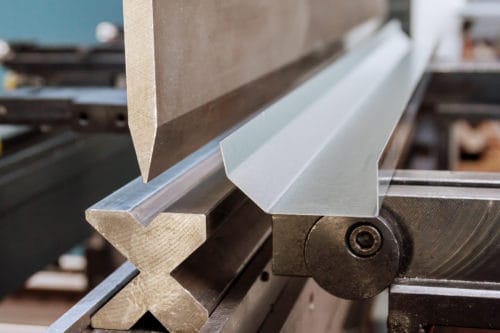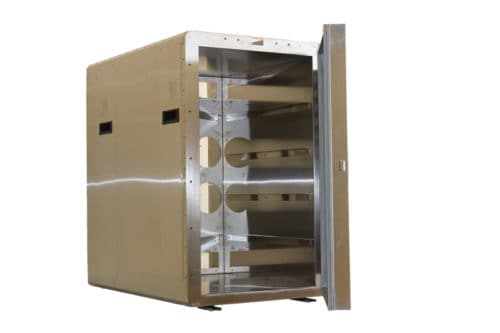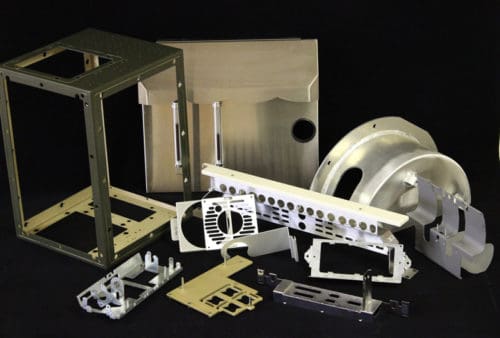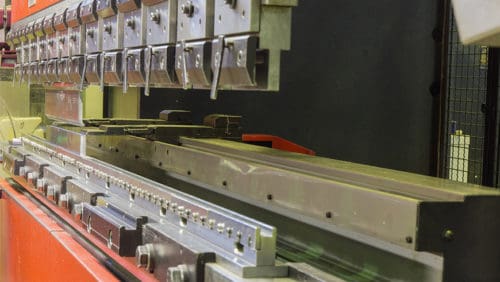Category Archive: Sheet Metal Fabrication
Many people refer to welding and metal fabrication as if they’re two different words for the same process. While both processes require working with metal, the terms are not interchangeable. Metal fabrication can be described as the process of creating a product out of metal. Welding is often a part of that process. There are a variety of processes in metal fabrication. Welding is only one of them. Yet welding is a specialized process that requires specific tools and knowledge not used during the other steps of metal fabrication. Learning how each process works can help you better understand the difference between metal fabrication and welding.

Welding and Metal Fabrication: What Are They Exactly?
Welding and metal fabrication are the processes used to shape, cut, bend, and join metal to make different products. Various tools and different methods are used throughout the process to achieve the desired result.
- Welding: A fabrication process where two pieces of metal are fused together by heat, pressure, or both is called welding. Welders use special tools to heat metal and form a bond to join two pieces or repair cracks. Typically, the bond forms completely as the metal cools.
- Fabrication: All processes that are used in building machines or structures from raw metals are considered metal fabrication. Processes may include cutting, burning, welding, machining, forming, and assembly. Sometimes, all processes of fabrication are completed in the same place, but some companies may outsource specific tasks, like welding, to other professionals.
Welding is a fabrication process, so it can technically be referred to as metal fabrication. However, there are many types of metal fabrication that don’t require welding. Therefore, a welder who only uses tools and processes used in welding cannot complete the entire metal fabrication process. Similarly, a metal fabrication shop without a welder cannot complete the welding part of fabrication without the right tools and skill set.
The Metal Fabrication Process
Metal fabrication is the entire manufacturing process used to create metal products or machines. Often, fabrication is completed by a group of specialists who complete different parts of a project. There are many steps in the metal fabrication process, which may include:
Bidding
Capable companies use a description of the product to create a bid for completion of the job. Bids may indicate the ability to complete the entire project in-house or include the cost of subcontracting some tasks to other professionals. One company will have a winning bid and begin the product.
Planning
Before any fabrication begins, the entire project must be carefully planned. Designers and engineers work with the client to understand the product uses and specifications. Then, a plan for the required tools and processes is organized by the team.
Production
The activities used to shape raw materials make up the production process. Production refers to all of the physical processes used to form the final product. These processes include:
- Cutting: Metal cutting is usually completed by machines. Waterjet and laser cutting are the most common technologies used for metal cutting today.
- Casting: Machine dies create molds for specific shapes. The fabricator pours molten metal into these dies to create metal parts.
- Forging: With the use of high-pressure machinery, raw metal is compressed so fabricators can bend and shape it.
- Punching: A punch press is used to punch pre-designed patterns into the metal for decorative or functional purposes.
- Drawing: This process places a specific amount of tension on liquid metal to pull it into a tapered die.
- Milling: A complex machine is used to shave the surface of metal, create angles, perforations, or holes into metal pieces.
- Turning: Metal is placed on a spinning platform to allow technicians to make radial cuts with a tool as the metal spins.
- Extrusion: Used to form cylindrical parts like pipes or wires, extrusion uses a ram to force billets through a die.
The Welding Process
 Welding is the part of the fabrication process used to join metal pieces together. Welders use a variety of specialized tools that comibine heat and pressure to fuse metal pieces together without compromising strength. Welding falls into two main categories:
Welding is the part of the fabrication process used to join metal pieces together. Welders use a variety of specialized tools that comibine heat and pressure to fuse metal pieces together without compromising strength. Welding falls into two main categories:
- Fusion Welding: The act of heating metal parts, then adding a filler to join them together, is called fusion welding.
- Solid-State Welding: A process that heats metal parts and joins them without using additives is referred to as solid-state welding.
Fusion welding and solid-state welding are used for different reasons. These are the four main welding processes used in metal fabrication:
- Shielded Metal Arc Welding (SMAW): A fusion method also known as stick welding, SMAW uses an electric current and welding rods to join metal surfaces.
- Oxy-Acetylene Welding (OA): A tank of oxygen and a tank of acetylene are used with a torch nozzle to create a flame that heats the metal while a filler rod is used for fusion.
- Tungsten Inert Gas Welding (TIG): TIG welding uses a non-consumable tungsten electrode to create the weld.
- Gas Metal Arc Welding (MIG): MIG welding feeds wire with a consumable rod fed through a continuous spool of electrode wire.
Metal fabrication requires a wide variety of processes to create many different products and machines. Welding is an important part of metal fabrication with its own distinct set of tools and processes. Contact the experts at T/J Fabricators to learn more about our metal fabrication processes, or request a quote to start your project today.
Sheet metal is commonly described by gauge, which indicates the thickness of the particular piece of sheet metal. Since the gauge measurement system is independent of both the imperial and metric measurement systems (i.e., a gauge value of 18 is not equal to 18 inches or 18 centimeters), someone unfamiliar with it may find it difficult to understand.
The following guide provides an overview of the gauge measurement system. It describes how it is used, provides conversion charts for various materials, and discusses how to read them.
How Are Sheet Metal Gauges Used?
The gauge of a piece of sheet metal refers to its thickness. While this value is not provided in imperial or metric units, it can be converted to one or the other using a gauge conversion chart.
Sheet Metal Gauge Charts
Carbon Steel Gauge Chart
| Gauge Number |
Inches |
MM |
| 7 |
.1793 |
4.554 |
| 8 |
.1644 |
4.175 |
| 9 |
.1495 |
3.797 |
| 10 |
.1345 |
3.416 |
| 11 |
.1196 |
3.038 |
| 12 |
.1046 |
2.656 |
| 14 |
.0747 |
1.897 |
| 16 |
.0598 |
1.518 |
| 18 |
.0478 |
1.214 |
| 20 |
.0359 |
.911 |
| 22 |
.0299 |
.759 |
| 24 |
.0239 |
.607 |
| 26 |
.0179 |
.454 |
| 28 |
.0149 |
.378 |
Stainless Steel Gauge Chart
| Gauge Number |
Inches |
MM |
| 8 |
.17187 |
4.365 |
| 9 |
.15625 |
3.968 |
| 10 |
.14062 |
3.571 |
| 11 |
.125 |
3.175 |
| 12 |
.10937 |
2.778 |
| 14 |
.07812 |
1.984 |
| 16 |
.0625 |
1.587 |
| 18 |
.050 |
1.270 |
| 20 |
.0375 |
.9525 |
| 22 |
.03125 |
.7937 |
| 24 |
.025 |
.635 |
| 26 |
.01875 |
.476 |
| 28 |
.01562 |
.396 |
| 30 |
.0125 |
.3175 |
Aluminum Gauge Chart
| Gauge Number |
Inches |
MM |
| 7 |
.1443 |
3.665 |
| 8 |
.1285 |
3.264 |
| 9 |
.1144 |
2.906 |
| 10 |
.1019 |
2.588 |
| 11 |
.09074 |
2.305 |
| 12 |
.08081 |
2.053 |
| 14 |
.06408 |
1.628 |
| 16 |
.05082 |
1.291 |
| 18 |
.04030 |
1.024 |
| 20 |
.03196 |
.812 |
| 22 |
.02535 |
.644 |
| 24 |
.02010 |
.511 |
| 26 |
.01594 |
.405 |
| 28 |
.01264 |
.321 |
| 30 |
.01003 |
.255 |
How to Read a Sheet Metal Gauge Chart
(Click to Expand)

The gauge system was originally developed in Britain to specify wire thickness in a time when there was no universal thickness unit. While some changes have been made and, at one point, a replacement was planned, the general concept of the system has remained the same. Today, it is used for both wire and sheet metal.
Sheet metal gauge conversion charts allow for the conversion of the gauge measurement into standard or metric units. However, there are a couple of things to keep in mind to ensure you achieve the proper converted value.
- The standard or metric equivalent of a gauge value depends on the metal. For example, 18-gauge sheet metal would be 0.040 inches thick if made from aluminum and 0.048 inches thick if made from stainless steel. That’s why it is important to ensure you use the right conversion chart for the given piece of sheet metal.
- The difference in metric or standard value from one gauge to the next is not equal. For example, 18-gauge sheet metal made from aluminum is 0.040 inches, 20-gauge sheet metal made from aluminum is 0.032 inches, and 16-gauge sheet metal made from aluminum is 0.050 inches. The difference in thickness between 18-gauge and 20-gauge is 0.008 inches, while the difference in thickness between 18-gauge and 16-gauge is 0.010 inches.
Custom Sheet Metal Fabrication Services at T/J Fabricators
Want to learn more about sheet metal gauges and how to decipher them for your next metal fabrication project? The experts at T/J Fabricators have got you covered!
Equipped with extensive experience providing custom sheet metal fabrication services to customers across a wide range of industries, we have what it takes to meet all of your sheet metal manufacturing needs. We can assist you in all aspects of fabrication, from CAD design and material selection to cutting and forming to welding and assembly to finishing and storage. Our engineers can work with a variety of metals, including aluminum, cold-rolled steel, hot-rolled steel, galvanized steel, and stainless steel.
To learn more about our precision sheet metal fabrication capabilities, contact us today. To get started on your next project, request a quote.

T/J Fabricators is a leading provider of custom sheet metal fabrication services for customers around the world. Using state-of-the-art equipment, we form, bend, punch, and extrude even the most complex OEM components for an extensive range of applications. We pride ourselves on providing only the highest-quality sheet metal products through cutting-edge technology, skilled expertise, and premium materials.
What is Sheet Metal Fabrication?
Sheet metal fabrication is a category of manufacturing processes used to create products for numerous industries, including computers and electronics, food service, medical, military, banking, mass transit, banking, telecommunications, and many others. The actual processes involved may include any number of metalworking processes, including cutting, bending, forming, and stamping. Sheet metal fabrication consists of hot and cold forming processes, and each unique process provides different benefits based on the material and intended product.
Sheet Metal Fabrication Processes
Sheet metal fabrication processes create a wide range of products, from ATMs and retail display kiosks to commercial hand sanitizer stations and medical equipment. To create complex products and components with a high degree of precision, sheet metal fabricators incorporate a wide range of processes, including:
Cutting
Cutting removes material from a sheet metal blank to create the desired shape. A wide range of tools can cut sheet metal, such as blades, mills, laser cutters, electrode sparks, and waterjets.
Determining the most appropriate cutting method depends on the strength and thickness of the metal, as well as the complexity of the component. Physical cutters such as saws and mills provide an ideal cutting solution for large workpieces and thick sheets. In contrast, laser cutting is better for smaller or more intricate components that require a higher degree of precision.
Forming
Forming usually fits into sheet metal manufacturing after cutting and before finishing to create more complex objects. Sheet metal forming shapes the metal sheet with compressive force using various sheet metal forming methods:
- Bending. Bending uses press brakes to fold and bend sheet metal into desired shapes. The process requires strict engineering in advance of operations to ensure the material’s integrity during the procedure — especially with highly complex bends. Every material is different, and it is vital to have a thorough understanding of the material’s properties and limitations before attempting to bend it.
- Punching. Punching uses compressive force to create holes in the sheet in the desired pattern and shape. An operator places the sheet metal between a hollow shaped die and the punch, after which the punch presses against the sheet, deforming the metal and cutting a hole. The die forces its shape through the metal to create a punched hole, and the machine ejects the excess material.
- Extrusion. Sheet metal extrusion uses a similar process to punching because it uses a tool to punch a hole. Rather than removing the punched material entirely, the material gets extruded downward. This method is popular for fabricating self-tapping screws for storage systems, containers, and other enclosures.
- Embossing. Embossing also uses dies and compressive force to shape metal sheets. Instead of using a punch, fabricators use matching male and female dies to establish raised or recessed shapes and patterns in the metal without piercing the sheet. Embossing is frequently used to create patterns, textures, and writing on components for aesthetic purposes. It can also improve specific metal characteristics such as stiffness and traction or reduce static and friction.
Finishing
Metal cutting and forming processes often leave rough spots and sharp edges on the surface of the component. Finishing procedures use various tools to polish and clean edges and surfaces to create a smooth, flawless exterior. The parts may also be coated or painted to establish a barrier against moisture, UV rays, corrosion, heat, and other application-specific conditions.
Assembly
Assembly is the final step in the sheet metal fabrication process. Depending on the product, the assembly may include welding, riveting, bolting, or otherwise attaching or connecting components to create a final product.
Advantages of Sheet Metal in Fabrication
(Click to Expand)

Sheet metal fabrication is highly versatile and offers numerous benefits over other manufacturing methods, including:
Wide Range of Applications
Sheet metal is quite versatile, making it an ideal material for creating a wide variety of designs and components. Using a combination of cutting, forming, and finishing methods, sheet metal fabricators produce durable and complex solutions for everything from automotive parts to medical equipment.
Flexible Run Size
Sheet metal fabrication handles volumes ranging from small scale prototyping and sample runs to large-volume, full-scale production runs. Fabrication facilities for sheet metal products typically have space and equipment to quickly and efficiently complete production runs of all sizes.
Materials to Suit Applications
Sheet metal encompasses an extensive range of materials, from mild steel and stainless steel to aluminum, brass, and copper. Sheet metal fabrication processes and finishes are modified to suit each material’s particular physical requirements and intended application.
Surface Finishes
Sheet metal fabrication includes multiple surface finish options to improve aesthetics and enhance the physical properties of the sheet metal. Common surface treatments include painting, powder coating, galvanizing, and electroplating, among others.
Materials Used in Sheet Metal Fabrication
Sheet metal features a thickness of no more than 6 mm and offers a variety of material options. Each material offers unique benefits and characteristics that make it useful for specific applications, including corrosion resistance, tensile strength, stiffness, strength-to-weight ratio, and finished appearance. Specific steel alloys and aluminum are the most common materials for sheet metal fabrication, but brass, magnesium, bronze, and copper are also used.
What Type of Steel Is Used for Sheet Metal?
Manufacturers value steel for its exceptional tensile strength, but only certain types of steel are compatible with sheet metal fabrication. Steels often used for sheet metal fabrication applications include:
Designers and fabricators favor stainless steel sheet metal for its strength and corrosion resistance. A minimum of 10.5% chromium content gives stainless steel a protective layer of chromium oxide, which keeps it from rusting when exposed to moisture and other corrosive elements. This property makes it particularly useful for medical equipment, food processing and distribution, kitchen equipment and appliances, and industrial storage tanks, valves, and pipes.
Hot-Rolled Steel Sheet Metal Fabrication
Hot-rolled steel forms easily at high temperatures and cools into robust and cost-effective parts. It is important to note that hot-rolled steel shrinks as it cools, which creates stress within the material and may cause a small degree of deformation or warping. As such, hot-rolled steel is best only for applications where exceptional accuracy is not a concern.
Cold-Rolled Steel Sheet Metal Fabrication
Cold-rolled steel first undergoes the same production processes as hot-rolled steel. Once the sheets cool to room temperature, they are subjected to additional compression at room temperature to improve the steel’s density and tensile strength. Cold-rolled steel is processed to thicknesses up to 3 mm and valued for its smooth, clean finish. Manufacturers rely on this material for fabricating outdoor steel constructions, consumer goods and appliances, metal furniture, school lockers, and cabinets.
Aluminum
Aluminum sheet metal is more expensive than its steel counterparts but offers a lightweight option with an exceptional strength-to-weight ratio. Although not as popular as steel due to its higher price tag, transportation and aerospace manufacturers often prefer it to create lightweight components. Aluminum sheet metal also sees frequent use in small consumer goods, such as laptop cases and cell phones.
Expert Sheet Metal Fabrication by T/J Fabricators
At T/J Fabricators, we pride ourselves on providing superior-quality sheet metal fabrication services for customers in any industry. Our advanced facility and extensive portfolio of fabrication services allow us to produce even the most complex OEM components with exceptional speed and efficiency. We offer fabrication services using a vast selection of sheet metal materials. We are always happy to work with you to ensure that you have the perfect material, process, and finish for your project.
To learn more about our custom sheet metal fabrication services, please contact our experts or request a quote today.

Utilizing a comprehensive cold working process, manufacturers are able to form thin sheets of metal into a variety of components. This process, known as sheet metal fabrication, is highly versatile and includes steps, such as splicing, shearing, and riveting. Sheet metal is generally no more than 6 mm thick, and is available in many types. Choosing the appropriate sheet metal material for the desired application makes it possible to enhance certain component properties, such as:
- Corrosion resistance
- Finish
- Rigidity
- Strength
Request for Quote
Types of Sheet Metal
There are six major types of sheet metal material, each with its own unique advantages:
- Alloy steel
- Stainless steel
- Carbon steel
- Tool steel
- Galvanized steel
- Aluminum
Alloy Steel
As the name suggests, alloy steel combines multiple elements to enable a customizable set of properties. The main component of this material is carbon steel. Common additions include tungsten, chromium, and manganese, for rigidity, or vanadium and nickel, for strength. In addition to its versatility, alloy steel is also highly affordable.
Stainless Steel
This type of sheet metal is ideal for products that will be exposed to frequent moisture. It contains chromium, an element that significantly reduces corrosion caused by harsh or damp environments. Components made from stainless steel sheet metal fabrication can increase the lifespan of a product or structure, from kitchen sinks to office buildings.
Carbon Steel
Iron is alloyed with carbon in this sheet metal material, providing an option with high amounts of strength. Depending on the desired application, a manufacturer can choose from steel with low, medium, or high levels of carbon content.
Low amounts of carbon result in a highly versatile material, most commonly found in everyday objects like fences and gates. Medium carbon steel is a popular choice for automotive vehicles and appliances. Higher levels of carbon result in a slightly more fragile product, ideal for delicate items, such as wires.
Carbon steel is available in six different grades:
- A36 sheet metal
- A572-50 sheet metal
- A516-70 sheet metal
- AR400 sheet metal
- A588 sheet metal
- A1011 sheet metal
Tool Steel
Immensely versatile, tool steel is a rigid alloy containing about one percent carbon. As with alloy steel, the elements contained within tool steel vary in type and ratio depending on the desired application. Tool steel is resistant to abrasion, and functions well in extreme temperatures. Its properties make this type of sheet metal ideal for the construction of tools, such as punches, dies, blades, and hammers.
Galvanized Steel
Galvanized steel is available in two varieties: electro-galvanized sheets and hot-dipped metallic-coated sheets. The former is composed of cold rolled annealed steel. It has a pure zinc coating with no zinc spangle. The latter is composed of cold rolled hard steel plates coated with a mixture of pure zinc and an iron-zinc alloy. This type of galvanized steel offers more corrosion resistance, and is slightly more affordable than electro-galvanized sheets.
Aluminum
For applications that require a more lightweight material, aluminum is an excellent option. This type of sheet metal offers significant corrosion resistance even without a finish. Aluminum is also strong, and can undergo laser cutting, welding, and machining.
Precision Sheet Metal Fabrication From T/J Fabricators
Since our establishment in 1967, we at T/J Fabricators have been a leading supplier of fabrication services across a wide range of industries. We offer the following precision sheet metal fabrication capabilities:
Regardless of project complexity, our knowledgeable team of experts will work closely with you to create high-quality components fabricated to your unique specifications. Contact us or request your quote today to work with us on your next project.
 Sheet metal forming involves the use of force to deform metal without removing material. When the metal is carefully pushed beyond its yield strength — but not so far that it fails — it can be formed into shapes ranging from a simple bend to complex geometries. A range of precision sheet metal forming processes allow sheet metal to be fabricated, involving specialized equipment to stretch or shape the material.
Sheet metal forming involves the use of force to deform metal without removing material. When the metal is carefully pushed beyond its yield strength — but not so far that it fails — it can be formed into shapes ranging from a simple bend to complex geometries. A range of precision sheet metal forming processes allow sheet metal to be fabricated, involving specialized equipment to stretch or shape the material.
Bending
Dies are used to form smaller metal components into the shape of the die, while longer pieces of sheet metal can be shaped with press brakes. The bending process causes stretching at the outer arc and compression on the inner angle. Just as with any other flexible material, the metal tends to revert slightly after forming the curve; so, to compensate for the springback, this process requires strategically over-bending the metal.

Laser Cutting
Holes can be burned into metal more quickly and precisely than other methods by using high-powered lasers. Metal also can be automatically incised with laser-cutting computer numerical control machines. The lasers used are one of three types of lasers: CO2, neodymium, or yttrium-aluminum-garnet.
Punching
When sheet metal is placed between a punch and a die, it works similarly to a paper hole punch. The force of the metal being pushed against the die creates holes in the metal.
While the holes are seemingly created with one swift movement, in reality, it is a four-step process:
- The metal is deformed.
- The hole is scored or cut.
- The metal is broken along the cut line
- The punch slug is ejected.
Extrusion
In sheet metal extrusion, a tool is used to punch a hole and extrude the material downward at the same time. This can be used to create holes for self-tapping sheet metal screws or machine screws, and it reduces the need for secondary operations. The process is commonly used with enclosures, components for furniture, storage systems, and any other component that requires punching and extrusion.
Embossing
Embossing uses matched male and female embossing dies to create raised or sunken patterns in sheet metal. This set of dies includes a punch and a cavity. Metal thickness and properties determine the maximum depth of the embossing. This process can be used in the following applications:
- Function – Embossing can be used to improve a performance characteristic of a metal component. It can be used in a variety of ways, including reducing friction and static, enhancing traction, improving metal stiffness, or increasing surface area.
- Visual – Embossing produces patterns on sheet metal components that can be purely aesthetic. Applications include automotive trim elements, consumer products, or electronic enclosures.
Precision Sheet Metal Fabrication at T/J Fabricators
When your application requires precision and reliability, you need a company that has been proven to adhere to the strictest of quality standards. At T/J Fabricators, Inc., we hold ourselves to stringent standards of excellence, with the use of state-of-the-art equipment and digital scanning. For more information about our capabilities, contact us today or request a quote here.

 Welding is the part of the fabrication process used to join metal pieces together. Welders use a variety of specialized tools that comibine heat and pressure to fuse metal pieces together without compromising strength. Welding falls into two main categories:
Welding is the part of the fabrication process used to join metal pieces together. Welders use a variety of specialized tools that comibine heat and pressure to fuse metal pieces together without compromising strength. Welding falls into two main categories:









